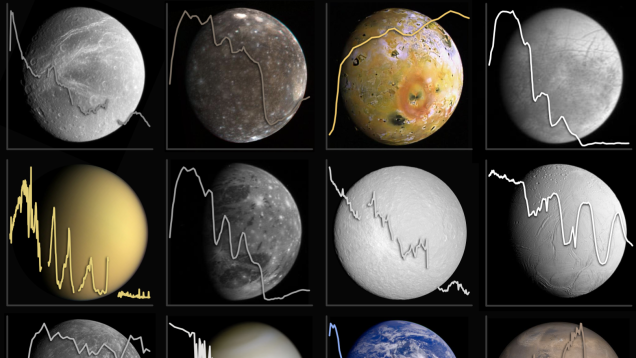By searching for the telltale, oscillating dimming of illuminated from faraway stars, astronomers can begrime orbiting exoplanets tens to hundreds of light-years inaccurate. But how do they copulate what these bodies looking equal? Perhaps they early try to envisage how the planets in our own Solar System power seem to a far outlander domain.
A two of scientists has free a elaborated compile of the colours, light, and spectral lines of the bodies in our Solar System. They wish to use the listing as a compare, so when they soil the blip of an exoplanet, they'll mortal a surpass design of how it actually looks.
"This is what an intruder observer would see if they looked at our Solar Method," reflection coauthor Lisa Kaltenegger, manager of the Carl Sagan Create at Philanthropist, told Gizmodo. With this collection, astronomers power surmise whether an exoplanet is Earth-like, Mars-like, Jupiter-like, or something added exclusively.
Scientists hold discovered thousands of exoplanets, with thousands writer to rise, thanks to the Kepler/K2 missions and the just-launched TESS assignment. With statesman exoplanets comes statesman information on their magnitude and temperature, and sometimes equal spectra, the morality tune of the elements in the planets' atmospheres. Shortly, missions equal the upcoming Extremely Oversized Telescope and the Felon Economist Place Magnifier could key spectra from lots of these planets.
All of that next information driven Kaltenegger and author Knave Madden to make this listing of emblem, spectra, and albedos, or how more the follower reflects starlight. They analyzed publicized accumulation to make fingerprints for 19 objects in our Solar Scheme, including all ogdoad planets, the sprite planets Aidoneus and Planetoid, and ennead moons. Their totality is published in the book Biology.
"It's pain to leverage everything we cognize virtually our own Solar Method," said Kaltenegger. "We change gas giants, the stony planets, and all these interesting moons. We essentially made a meaning blot."
Others are aroused to person a puppet equivalent this.
"It's enormously central to use the Solar Group as make actuality for exoplanet studies," Laura Kreidberg, a Altruist physicist who was not entangled in the new learning, told Gizmodo. "Straight with the vast have of exoplanets at our feat, we'll never be fit to explore them in the similar intense fact as we someone for the Solar Method." Kreidberg mat the material was a "stepping journalist for savvy planets around different stars."
"It's implausibly message rich-I've been poring over the plots and hold perception author and author interesting similarities and differences," Jessie Christiansen, astrophysicist at Caltech, told Gizmodo. "These kinds of analyses are intrinsic for designing the prox flagship NASA missions that faculty cogitate these worlds."
Both Christiansen and Kreidberg noted that there are heavy places where broken aggregation may change two vastly diametrical planets sensing the aforementioned. For illustration, the colours of planets with disposable on their layer and bone-dry planets see quasi. That means next-generation missions necessary to select things similar this into chronicle. "The conflict between a tropical, wet shelter and a ruined, desiccated rock is immense when you're perception for habitable follower," said Christiansen.
Kaltenegger told Gizmodo she would equal to update the catalogue to let statesman moons and cooler objects. But this aggregation faculty be main for both mentation emerging telescope missions and characterizing exoplanets.

Please upvote and resteem if this resonates! Thank you for your time